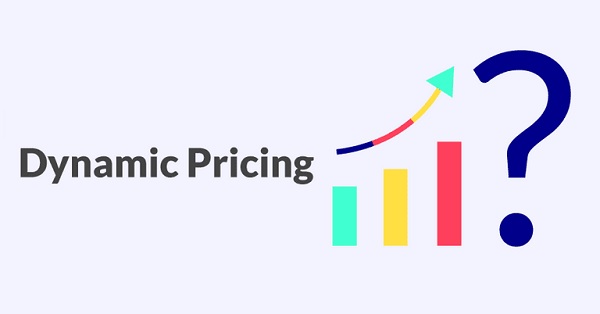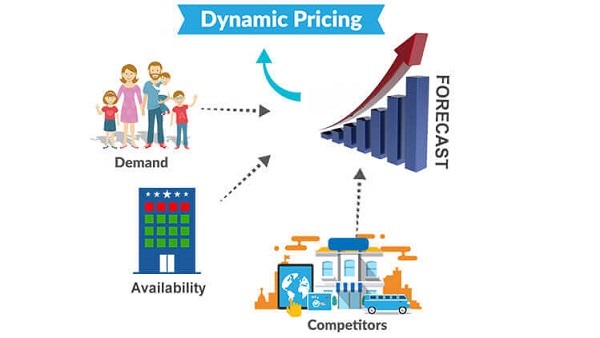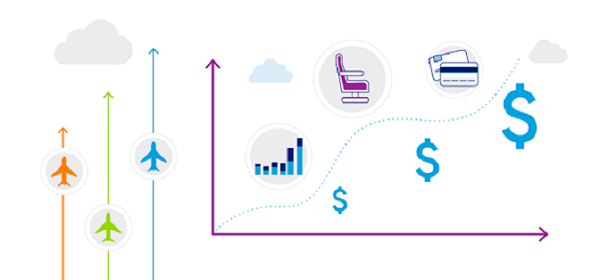
Dynamic Pricing: Benefits, Strategies, and Examples
Dynamic pricing is a hot eCommerce topic that is taking the industry by storm and highly depends on variable factors such as demand, supply, customer behavior, and seasonality, all of which must be continuously monitored to stay on top of the market.
Among numerous pricing strategies and methods, dynamic pricing stands out as a powerful weapon.
We covered all, from the essentials of dynamic pricing in eCommerce to the implementation. Keep scrolling.
What is dynamic pricing?
Dynamic pricing, or surge pricing, is demand pricing or time-based pricing. This pricing strategy allows businesses to set flexible prices based on current market demands. To put it more simply, this is a strategy in which product prices continuously adjust. It may be a matter of minutes, hours, or days, depending on the type of market.
In practice, dynamic pricing is often a responsive or a reactive pricing strategy. This means that you adjust your prices according to various market changes.
Generally speaking, dynamic pricing requires instant actions in response to supply and demand changes in order to capitalize on them which is also the main incentive for companies to implement this pricing strategy.
For a moment, let’s imagine we could go back in time – perhaps 20, 30, or 50 years. What questions would companies be preoccupied with?
How many people want a certain product? How many products are there in stock? How many product varieties exist? How many competitors are out there?
Nowadays, the emergence of tools for real-time pricing has made answering these questions much easier. There are many advanced ways to acquire and analyze pricing data. These processes help businesses make data-driven decisions easier.
Main benefits of dynamic pricing
Dynamic pricing changes have become one of the most important tools to implement for several reasons. Although it has its downsides which we will be pointing out in the following paragraphs, let’s focus now on the main benefits of dynamic pricing.
- Price optimization enables businesses to avoid scenarios of underpricing (missing out on potential revenue) or overpricing (risking losing customers to competitors). During high-demand periods, a dynamic pricing strategy increases prices to maximize revenue, while during low-demand periods it decreases them and suggests discounts to boost sales volumes.
- Analyzing customer responses to various price points provides valuable insights into purchasing behavior, preferences, and price sensitivity for businesses to tailor pricing strategies effectively and offer customers personalized prices.
- By monitoring competitor pricing and market trends, businesses adjust their prices to remain competitive. This responsiveness helps prevent loss of market share and swiftly respond to changes in market conditions.
- Businesses avoid overstock situations by adjusting prices based on inventory levels, which can lead to lost sales and unhappy customers. During periods of excess stock, prices can be lowered to increase sales and reduce inventory. Conversely, prices can be raised when stock levels are low to maintain profitability and manage demand.
Types of dynamic pricing
Segmented pricing
This strategy requires pricing different customers different prices meaning that customers are divided per price segmentation. For example, high-value customers can be offered higher prices as they might put service speed and quality over price.
Time-based pricing
Businesses can use this product pricing method when they want to charge more for providing faster services meaning that customers will pay more to have same-day service or if reach the company close to the end of the working hours.
Changing market conditions
The situation in the market can change due to various factors. However, businesses must act accordingly. If sales start falling for some reason, the company will lower prices.
Peak pricing
This strategy can be used in many industries to charge more during peak hours. It has some similarities with time-based pricing, and you could look at it as its derivative. Both are at their core very dynamic approaches to pricing. Also, most companies that use these pricing strategies utilize a price optimization tool to improve their repricing process.
Penetration pricing
The penetration pricing strategy is used when businesses want to reach a large portion of the market. By doing so, future customers get familiar with the offered product. To do so, companies set prices below the market prices and tend to increase them gradually.
Price skimming
This pricing strategy is mostly used by companies that launch completely new products. Since there is no need to worry about price competitiveness, companies can set a higher price at first and lower it over time.
Value-based pricing
As the name suggests, value-based pricing means a customer has the upper hand. The price won’t depend on production costs, competition, and other factors, but mostly on how the customer perceives the product. The higher the value, the higher the willingness to pay. Thus, it’s no surprise that luxury brands mostly rely on this pricing strategy.
Bundle pricing
In the case of bundle pricing, different products can be combined and offered at a lower price. This is usually well received among customers since they get to pay less. The combination of offered discounted products must make sense.
Dynamic pricing use cases
We will now explore some real-life examples of using dynamic pricing in eCommerce and point out important concepts to consider when implementing this pricing strategy.
Dynamic pricing in the airline industry
Airlines utilize complex algorithms and vast amounts of data to adjust prices dynamically, ensuring they maximize revenue for each flight. For instance, prices often start lower when tickets first go on sale and gradually increase as the flight date approaches and seats fill up. Conversely, if a flight is not selling well airlines might lower prices or offer promotions to attract more passengers.
This approach allows airlines to optimize their load factors (the percentage of available seats sold), ensuring they achieve the highest possible revenue per flight. It also enables airlines to remain competitive by quickly responding to changes in the market, such as new routes introduced by competitors or sudden shifts in travel demand due to economic or seasonal factors.
Dynamic pricing in the airline industry benefits the airlines through increased profitability and efficient resource utilization and offers passengers a range of price points, encouraging early bookings and last-minute deals depending on their flexibility and travel needs.
Here, it is important to pay attention that price fluctuations can cause confusion and frustration as some customers often perceive price changes as unfair or exploitative. Transparency is key, in these situations and always, as companies should tend to keep their customers informed on factors influencing pricing.
Uber – real-life example
Uber learned implementation difficulties and the importance of transparency the hard way, as its users did not receive dynamic pricing well. Uber was accused of surging prices (because it was primarily known as a low-cost service) and even warned by the city’s top lawmaker to put their prices under control as they were charging astronomic prices during the snowstorm in New York and the area close to the deadly hostage siege in the city center based on higher demand. Today, they are very transparent in explaining how their dynamic pricing algorithms work.
Dynamic pricing in sports
Dynamic pricing in sports involves adjusting ticket prices for games and events in real-time based on various factors such as team performance, opponent ranking, weather conditions, day of the week, and even last-minute demand. For example, ticket prices for a highly anticipated match between top rivals or during a winning streak increase due to higher demand. Vice versa, tickets are usually cheaper for less popular games or lowered due to the weather conditions.
Sports organizations utilize sophisticated algorithms and data analytics to optimize their revenue streams by capturing consumer surplus—charging higher prices when demand is high and offering discounts to fill seats when demand is lower. It also helps manage attendance patterns by ensuring better crowd distribution across games. Overall, dynamic pricing in sports creates a more flexible and responsive ticketing system that aligns prices with real-time market conditions, enhancing the economic efficiency for teams as well as accessibility for fans.
Even though other industries, primarily travel-related, were pioneers in dynamic pricing, the implementation process in sports was rocky with a learning curve and mixed reactions from fans. It was initially adopted by major league teams in baseball and basketball, the approach has since spread to other sports.
Ticketmaster – real-life example
Pricing in entertainment events operates similarly to pricing in sports events. Is anyone ignorant about the Ticketmaster affair surrounding Taylor Swift’s Eras tour? We doubt it, but here is the excerpt.
It was found that Ticketmaster, the entertainment industry leader, controls about 70% of the ticketing and live events market indicating a non-competitive market. The company can not base its prices on competitors’ but mostly on demand. In the case of unexpected extreme demand for Swift’s concerts, the company was accused of boosting exclusivity and price discrimination due to enormous ticket prices. Now, the public is questioning whether dynamic pricing is ethical.
The fact is that dynamic pricing can not be either ethical or unethical, it is a business’s responsibility to implement all processes ethically and compliently. When it comes specifically to prices, transparent communication is paramount, while considering confidential information.
Dynamic Pricing Implementation
One of the most common misconceptions about dynamic pricing is that it is difficult to implement, but this doesn’t have to be. Mostly, it depends on the dynamic pricing software you choose.
Ensure that your software can perform data extraction on any website and provide structured product data beyond current prices, capture historical data and additional product data for more detailed market analysis. Also, software must be able to monitor hundreds of thousands of different products and offer monitoring frequency up to several times a day. Depending on your products, market situation, and competition you can decide how often to perform monitoring. Setting the right pricing strategy and therefore repricing itself would be mission impossible without constant monitoring of market prices and price analysis.
Price2Spy can serve you well
Price2Spy is one of the pioneers meaning one of the most experienced dynamic pricing software on the market. Widely recognized for ease of use and great customer service, it can help you define your pricing strategies and make the right repricing decisions. It offers a completely automated approach to pricing, from up to 8 times per day price monitoring to flexibility in repricing.
For now, make Price2Spy a dynamic pricing engine for your online store for free to experience how it benefits your business.






